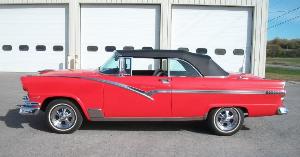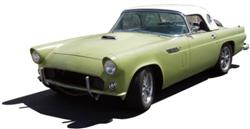|
Author
|
Message
|
|
Nat Santamaria
|
|
|
Group: Forum Members
Last Active: 3 Years Ago
Posts: 165,
Visits: 4.8K
|
I re gapped the plugs back to .036 - no difference. The Holley rep felt it was running to lean. So I adjusted the screws to richen the mixture- no difference. Upon acceleration it bogs down. If I really try to accelerate it sputters and hesitates. When I release the pedal a bit it is better and runs ok slowly gathering speed but doesn’t seem to be running cleanly or crisply.
I am wondering if I should have gone with 390 CFM (6.5 PV) as opposed to the 450 CFM (8.5 PV)
Man this is frustrating.
|
|
|
|
|
crab
|
|
|
Group: Forum Members
Last Active: 13 Years Ago
Posts: 59,
Visits: 241
|
Longshot, but check your vacume source for proper vacume, I think its ported, and that the advance is working both mechanical and vacume in the distributor. I recently discovered my Firebird that had been sitting in my heated shop for over a year had the shaft frozen up and did not advance at all. It had the same symptoms and would not accelerate at all practically, once I fixed it she hauls a$$...
|
|
|
|
|
charliemccraney
|
|
|
Group: Moderators
Last Active: 28 minutes ago
Posts: 6.1K,
Visits: 442.9K
|
The 450 should be fine. I have a lack of knowledge about Holley carbs but.. Isn't the screw an idle adjustment? Does it make any difference in the way the engine runs? An idle screw should provide a significant difference from all the way in to all the way out, assuming everything else is within reasonable operating parameters. In the case of my Edelbrock, the engine will not keep running if either of the two idle screws is turned all of the way in - this is normal. Too far out and it starts running funky. According to the plugs, how is the engine running?
Lawrenceville, GA
|
|
|
|
|
Ted
|
|
|
Group: Administrators
Last Active: Yesterday
Posts: 7.5K,
Visits: 205.8K
|
At first it sounded like the accelerator pump adjustment but with the additional info it's leaning more to a problem related with the carburetor internals and specifically the gasket between the metering block and the main body. But check the accelerator adjustment first anyhow as it only takes a minute. At full throttle, there should only be ~0.015” of clearance remaining at the adjustment location before the diaphagm itself is in a position to bottom out. If the accelerator pump linkage is loose or sloppy in the idle position, hesitation issues will come to the forefront. If that checks out okay, then check for the power valve bottoming out in the power valve cavity and not allowing the metering block to fully cinch down on the metering block gasket. Also check the main body where the metering block mates up to it to insure it’s not warped. Just take a straight edge and check the main body in both diagonal directions across the face of it. Ignition timing being too far retarded or the vacuum advance chamber not working will also create some off idle hesitation issues but your descriptions points to a lack of fuel or leaness as you lay into the throttle after you’re already moving. Does the engine slow down at idle when the vacuum advance to the distributor is unhooked? If so, then you’re either on direct vacuum to the distributor or as uncleaud brings up, too much transition slot is exposed in the primary throttle bores at idle. But check that the mechanical advance is working anyhow.
  Lorena, Texas (South of Waco) Lorena, Texas (South of Waco)
|
|
|
|
|
rgrove
|
|
|
Group: Forum Members
Last Active: 4 Years Ago
Posts: 498,
Visits: 3.5K
|
Have you checked to make sure the base plate is tight enough? Otherwise there will be vaccuum leaks which will cause those symptoms. I would certainly check that before taking it apart. You could try spraying carb cleaner around the carb while idling. If speed changes, you know its a vaccuum leak and not an issue with jets/power valve, etc.
Ron Grove Wauconda, IL
|
|
|
|
|
oldcarmark
|
|
|
Group: Forum Members
Last Active: Yesterday
Posts: 3.7K,
Visits: 32.6K
|
Nat,Something else to check is the float level.Make sure the motor is cold.If you unscrew the plug on each float bowl the fuel should just trickle out of the hole.The power valve should be rated as half of the engine vaccuum reading at idle with car in drive if its auto.To use the 8.5 valve you would have to have 17 in. vacuum.Many of these carbs use the 6.5 power valve so it wont open until engine vaccuum drops below 6.5 in vac.
 
|
|
|
|
|
Ted
|
|
|
Group: Administrators
Last Active: Yesterday
Posts: 7.5K,
Visits: 205.8K
|
oldcarmark (3/5/2009)
The power valve should be rated as half of the engine vaccuum reading at idle with car in drive if its auto.To use the 8.5 valve you would have to have 17 in. vacuum. Many of these carbs use the 6.5 power valve so it wont open until engine vaccuum drops below 13 in vac.Mark. I’ll have to disagree with you on this one. The rule of thumb for power valves is to insure that the opening point for a power valve is at least 2 in/hg below the manifold reading at idle. With an automatic transmission, this means taking the manifold reading with the transmission in ‘drive’. A #65 power valve opens when the vacuum drops below 6½ in/hg. A number 85 power valve opens when the manifold vacuum drops below 8½ in/hg. Don’t know who originally started the misinformation regarding using a power valve that’s ½ the manifold vacuum but its definitely all over the web now and is not the correct way to properly tune the power enrichment system. Each combination will vary somewhat in power valve requirements but the #65 power valves are generally a good fit in most applications as they will remain closed until the manifold vacuum drops below 6½ in/hg. In rare cases, a power valve with a higher opening point will remove a surge condition that can occur in some cruising and light acceleration situations. Hence the different options for power valves. And for those that really like to tune, there are ‘staged’ power valves with two stages or metering for two different opening rates. Many of the oem equipped Holleys for the trucks had these 'staged' valves. Another thing to remember about power valves as that their opening rating will change as they age. As power valves get older, the diaphagm stiffens thereby making the rating artifically higher or opening at earlier or higher vacuum rates. At rest a power valve on a non-running engine is open and as soon as the engine starts, it closes. An aged power valve can eventually get to the point that it will not close at all.
  Lorena, Texas (South of Waco) Lorena, Texas (South of Waco)
|
|
|
|
|
oldcarmark
|
|
|
Group: Forum Members
Last Active: Yesterday
Posts: 3.7K,
Visits: 32.6K
|
Hello Ted, I got the info about power valves from the Holley Performance catalogue."If the vehicle has a manual transmission,take vacuum reading with engine thoroughly warmed up and at idle.If the vehicle is equipped with an automatic transmission,take the vacuum reading with engine thoroughly warmed up and idling in gear.In either case ,the power valve selected should be 1/2 the intake manifold vacuum reading taken.EXAMPLE:13"Hg vacuum reading divided gy 2=6.5 power valve.If your reading divided by 2 lands on an even # you should select the next lower power valve.EXAMPLE:8"Hg vacuum reading divided by 2=4.Since there is no #4 power valve you should use 3.5".I would think this is what is being picked up off the internet directly from Holley.In Nat's case he has the 8.5 power valve.Is possible the valve is allowing too enriched mixture too soon?I seem to recall his motor is completely stock.When I installed my 390 CFM Holley last year I had to increase the main jets to #54 not 56 as Nats is equipped with.The power valve on mine is #65(6.5).I have no bog or hesitation during transisition from off idle until the powe valve opens up.I am sure my 56 Fairlane is a heavier car than Nats T-Bird and doesn't need fuel sooner than when the 6.5 valve opens up.Maybe he should try to jet one size smaller and change the power valve?I am sure Nat is pretty frustrated at this point.If you recall he bought (I think brand new)carb which he has now because the one he paid to have rebuilt didn't work properly.Is it possible that the carb(s) are not the problem and maybe something mechanical is causing the problem he is having?If I recall some of the symptoms were similar to last time.Maybe something like the ground wire inside dist losing ground when the advance starts moving?
 
|
|
|
|
|
GREENBIRD56
|
|
|
Group: Forum Members
Last Active: Last Year
Posts: 1.7K,
Visits: 102.7K
|
Nat - Do you have an auto (Ford-o-Matic) tranny in your bird? Because of the second gear start - mine is very sensitive to idle speed. Raising it 50 revs got rid of the hesitation - but puts too much torque against the converter to suit me when sitting at a light. When I drop it back - you have to put an egg under your foot. Starting in low - no problem.

Steve Metzger Tucson, Arizona
|
|
|
|
|
Pete 55Tbird
|
|
|
Group: Forum Members
Last Active: 4 Years Ago
Posts: 721,
Visits: 93.2K
|
Nat. Time for some HOMEWORK on your part. We need to know. !, what is your engine manifold vacuum? Do you have a timing lite? Is BOTH the distributor vacuum AND mechanical advance operating correctly? Can you dis-connect the hose to the distributor advance, plug it then connect a SECOND hose to the distributor advance. Then idle the engine with the timing lite on the marker on the balancer and suck on the open end of Second rubber hose and WATCH the Timing ADVANCE. Goose the throttle to see if the mechanical advance changes the timing on the timing lite. FORGET THE POWER VALVES. Not an issue. Lack of fuel when you press down on the gas pedal= accelerator pump. TELL US AGAIN in GREAT DETAIL just what is going on. You want a solution DO SOME WORK. It is really that simple. Pete
|
|
|
|